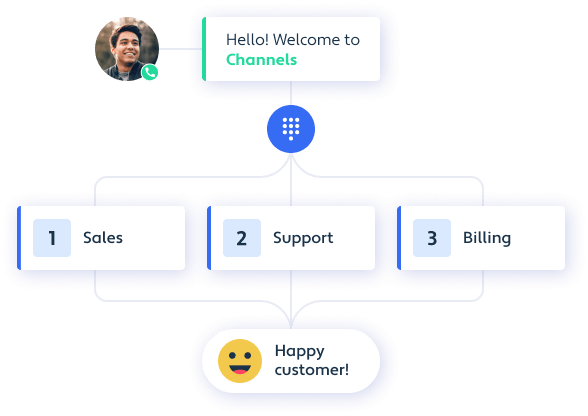How To Resolve 5 Most Common Customer Service Problems

As one wise man said: The problem is not the problem. The problem is your attitude about the problem. – Captain Jack Sparrow
And customer service problems are not the exception. So the best way to resolve them is to make a principle out of them.
In this article, I will present to you the 5 most common customer service problems. And don’t worry, you won’t be left alone with them.
You’ll get the guidelines to resolve them at once.
To be more precise, I will show you how to:
…become more empathetic
…avoid customers’ anger caused by long resolution time
…not to let a transfer become a customer service problem
…behave when you don’t know the answer to the customer question
…make your life easier with the help of the right customer service tools
…solve any of customer service problems by making a principle out of it
Before I do so, let me tell you a quick story…
Before working for Channels, I was a waiter in a charming Italian restaurant. It was my first job, though.

The restaurant was located in a calm residential area. There were also a couple of companies nearby.
It consisted of two halls, very different from each other. One of them was more like «homey and fast». It had white red tablecloths and dark brown chairs, more suitable for lunch than a date.
Another one downstairs opposite was very elegant and romantic: muffled light, gray shades, quiet music.
So accordingly to all I mentioned before, we had 2 types of clients.
Those, who want just to eat, attracted by lunch deals. And those who are looking for a nice atmosphere and delicious food.
The restaurant had a pretty diverse menu: steaks, mules, shrimps, risotto, ravioli, pizza, good wines, and craft beers.
Anyway, macaroni with chicken, broccoli and garlic sauce, and beer from concentrate were the most popular orders.
My job was to service the customers and take the phone orders.
Sounds simple, right?
Moreover, I also had to encourage people to try new things, make them leave their comfort zone, and be open to the proper Italian cuisine.
I took care of customers’ comfort and solved any problems they had, so they will come back again and bring their friends.
With time, I worked out my own principles, which helped me to do my job well and can help you too. Here are some of them.
The Most Common Customer Service Problems vs Principles
All right, let’s turn it into the attitude to solve the 5 most common customer service problems.
If I were to put it in one sentence, I’ll say that all you need to do is to change your attitude about the problem.
So instead of trying to solve it, make a principle out of it. Create an iron rule and follow that rule no matter what.
That way you can not only resolve the problem but also prevent it from happening again.
For example, you have an allergy because of chocolate. You can go to the doctor or buy an allergy cream. In both cases, the allergy will probably go away.
But you also can make a “no chocolate” principle, that way you will never have an allergy again.
So, here is the list of the top 5 customer service problems and such principles to eliminate them.
Table of contents:
-
-
- Customers are put off by rude or unhelpful customer service staff
- Customers receive the wrong answer from a customer service rep
- Not enough marketers prioritize implementing customer service tools
- Customers see the speed of resolution as the most important aspect of the customer service experience
- Customers waste time on explaining their problem to multiple people
-
42% of customers are put off by rude or unhelpful customer service staff
Problem: Lack of customer empathy
Principle: Try on customers’ shoes
What is customer empathy?
Customer empathy means walking a mile in the shoes of your customers, aiming to understand their feelings and perspectives, and using that understanding to guide our actions.
But today I won’t talk about types of empathy or how does it differ from sympathy. All this information and even more you can find here, it’s an interesting read and might be helpful for you.
Today I would like to focus on the importance of customer empathy and what you need to do to develop your empathy skills.

My day at work started by checking everything in the restaurant. I was checking literally everything: if there are no crumbs on the tablecloth, if there are papers and soap in the toilet if the table is not too far away from the chair.
I put myself in the body of a consumer and made the whole customer journey.
Why?
There are 3 reasons:
- You can predict actions and reactions and prevent possible customer service problems.
- It’s the only way to see the problem from the perspective of a customer.
- It allows you to start thinking like a consumer, and trust me, it will help you a lot;
High Customer Empathy leads to stronger financial performance, increased customer satisfaction, and customer loyalty.
It also provides an emotional bridge between you and your clients. And as far as you are a part of the company, your clients feel a deeper connection with the brand itself.
While you are not empathetic, you negatively affect the company’s reputation. You miss the opportunity to better understand your customers, which could make your life a lot easier.
It costs you nothing to be empathetic and you can benefit a lot from that.
Now, when we know that, let’s see the ways you can deal with the lack of empathy.
Solution – Customer Empathy Technique
Empathy Technique – Feel, Felt, Found.
That’s a very cool technique created by Apple. That one can work even if you don’t feel empathetic.
-
-
-
-
-
- Feel
-
-
-
-
Empathize with how the customer feels in that moment, and let them know that you understand.
-
-
-
-
-
- Felt
-
-
-
-
Explain that you, too, once felt that way in the past.
-
-
-
-
-
- Found
-
-
-
-
Tell the customer how you found that your concern was actually incorrect.
Need an example?
That’s how I actually bought a new phone last week.
Customer (me): iPhone 11 Pro is just too expensive.
You: I can see how you’d feel this way. I felt the price was a little high. But I found it’s a real value because of all the built-in software, capabilities and of course camera. Do you know that Selena Gomez’s new video was shot on an iPhone 11 Pro?
For more solutions go here.
44% of customers have received the wrong answer from a customer service rep
Problem: Lack of Knowledge
Principle: Knowledge is power
Now, when I’m sure that the restaurant is ready for guests, I’m going to the kitchen to ask what special dishes we have and try them out.
It’s very important to know every single detail of the product your company sells. You also need to be ready for every possible question that customers may ask, just not to look stupid.
Of course, it’s impossible to know everything, so if you don’t know the answer, don’t try to cheat. Better come with an answer later, after you consult with the right person.
Otherwise, you will look even more stupid, as I did, once.

It was my first week at work, the restaurant was crowded. I had a very specific client, there was nothing in the world that could please him.
He asked me a question about the menu: “What does Prosciutto Crudo 13m mean?”. I said that Prosciutto Crudo is an Italian dry-cured ham. On what he said, “But what does 13m means?”.
At that moment I started to panic. Of course, I knew the answer, I just needed to calm down and think.
But the way he was looking at me stressed me even more. I just wanted him to stop asking questions.
So not thinking twice I said: “That means 13 meters, it’s a huge ham and Italians slice it on the very-very thin pieces.”
13 meters ham? Really?

But I said it with so much confidence that he just shook his head and ordered the pizza with 13 meters Prosciutto Crudo.
P.S. if my way of speaking convinced you too, note that 13 m = 13 months. It means that the ham was cured for 13 months and, honestly, I have no clue what is the size of it.
REMEMBER! It’s impossible to know everything. I know, you would love to… But still, it’s impossible.
If you think you may forget, write it down 4937486 times.
Even though sometimes you feel that there is no question that you couldn’t answer, trust me, there is. That’s why you need to know what to do in such a situation.
Solution #1 – Come back with an answer
There is nothing shameful to admit that you can’t answer the question at that very moment, but with one caveat. And this is to use positive language.
Negative words may create a bad association with your product or brand. While through positive language you can redirect customer’s moods.
Never say “I don’t know”. Better say “It’s a very good question. Let me check on that”.
And trust me, there are thousands of different ways to say “I don’t know”, just be creative, you know…
Solution #2 – Knowledgebase
You might think of how knowledgebase can resolve your problem?
First of all, very often customers like to find a solution themselves. The same way you do when you google “nose hurts red inside the blood” or “hand swollen pain” before going to the doctor. So give them a chance to do that.
On the other hand, the knowledge base is like cheat sheets for you. So you can use them when your customer asks you a question you don’t know the answer to.
Only 63% marketers prioritize implementing customer service tools
Problem: Lack of necessary Customer Service Tools
Principle: Arm yourself
Nowadays customers are demanding like never before. They want faster and better.
These new expectations lead to new challenges. And to be able to resist them you need to stock up on helpful tools.
Otherwise, you are like 300 Spartans fighting against the army of many thousands.

Come on, it’s not 480 BC anymore, we live in the 21st century. There are plenty of tools that can help you in this unequal battle.
You may wonder how inventive this world is…
Solution #1 – Pick up the right tools according to your business needs
For example, you have phone software.
It would seem, why do you need it. But with the help of this customer service tool, you can really get rid of a pain in your ass.
We all know, that the majority of customers would call instead of reach out online. They want to get a quick answer from the real person, easy-peasy.
So how can phone software make your life easier?
With phone software, you can take as many incoming requests as you need. Moreover, you don’t need to be in the office to answer your customers’ calls.
You can transfer the call with a single click, the same way you can invite other callers to the conversation.
You can create the call script that will guide you through the call, or just gather all key information from the caller.
It also provides you the possibility to save time and resources by implementing such features as IVR.
You can record calls and use them for training your agents or as refreshment before the next conversation.
It also provides daily reports, so you can monitor everything you do and optimize your efforts.
And it’s just a small part of how such a tool like Channels can help you. Find out 11 more tools here.
Lucky you are!
Today you can sign up for a 7-day trial and fully test our software for free.
- A free phone number
- 24/7 Customer Support
- No credit card required
- Access to the features such as IVR, Call Recordings, and more
Don’t buy a pig in a poke, check it out yourself!
89% of customers see the speed of resolution as the most important aspect of the customer service experience, regardless of channel.
Problem: It’s taking very too long to solve a problem
Principle: Communication is the key
The part of my job was also the training of the new waitresses. And they all made the same mistake, very common in customer service.
When the restaurant is full, the waiting time is getting longer. So some people get frustrated.
Is it because they need to wait for the food?
Well, partly yes.
But most of the people are angry because they didn’t know that they will need to wait for that long. Because the waitress simply didn’t mention the long waiting time while taking an order.
Actually, long waiting time is one of the most frustrating customer service problems.
Why?
That’s obvious – people hate waiting.
But do you know what people hate even more than waiting?
Waiting when you don’t know the reason or details.
Many things can affect time, such as problem complexity, team communication problems, etc.
And sometimes it’s simply impossible to provide a solution quickly.
What will help you in this situation is proactive communication, whether with a client or with each other in a team.
I taught new people at the restaurant to inform clients before taking an order, so then they can make their own decision to wait or to find another place.
The same thing with the dishes that need more time to get cooked, such as steak or risotto.
If you inform the client about that proactively, they won’t be mad.
We are all humans, and we can understand that some customer service problems take more time to be fixed.
But what pisses us off is ignorance.
There is one more thing. To make a good customer experience out of a bad one, communicate with the client.
For example, come 10 minutes before the time is over and say that the pizza is already in the oven, so it will be ready in 5 minutes.
I bet they would like to know that someone cares and does his best to solve the problem.
Let’s sum it up.
Solution #1 – Proactive communication
1. Inform
Inform the customer about the estimated waiting time.
2. Explain
Explain why it will take a little longer than usual to deal with the customer service issue.
3. Communicate
Communicate with the client during the problem-solving process. Let him be a part of it, show that you care.
72% of customers blame their bad customer service interaction on having to explain their problem to multiple people
Problem: Transferring a customer over and over
Principle: Transfer as a last resort
You don’t need to be a specialist to know why people hate when they got transferred. And that’s also obvious that one person can’t know everything.
So if you decided to transfer the caller, just make sure that it’s necessary and you are transferring to the right person.
One competently made transfer won’t make any harm. It becomes a problem when the caller keeps getting transferred or wasn’t warned.
So here is how to don’t let transferring become one of the customer service problems.
Solution #1 – IVR
Thanks to the IVR, you will help your clients reach the right agent directly, without having to forward the call.
IVR allows you to upload a welcome message, after which your client will be able to select one of the keys on the keypad of his phone to be connected to the agent.
E.g. After pressing ‘1’ the customer will be connected to the customer service department while clicking ‘2’ with the sales department.
Thanks to this feature, your clients will receive help faster, and the agents will only talk to clients with who they can efficiently assist.
Improve customer experience with IVR

In Channels, you can add and configure the IVR system in less than 3 minutes. Improve customer satisfaction and turn your customer service into a profit center. Now, with a 7-day free trial to test ins and outs of Channels.
Try it out. No commitment, no credit card required. A free phone number to start with.
Solution #2 – Explain
Sometimes you still need to transfer the caller, even though your company uses IVR.
Never transfer anyone without an explanation. Tell as many details as possible: why are you transferring, who are you transferring the call to, etc.
Solution #3 – Internal communication
There is one more thing you need to know about:
72% of consumers see having to explain their problem to multiple people as poor customer service.
While transferring, make sure you handed over all the necessary information about the customer and its problem, so he doesn’t need to repeat himself 100 times.
Let’s wrap it up.
All customer service problems are solvable. The hardest part is to notice the problem. If you did it, you are halfway to the win.
Now, just change the attitude. Stop considering a problem as a problem. Take it as a puzzle on the way to better customer experiences.
Once you start making a principle out of any of the customer service problems and follow these principles, you will put together the puzzle.



